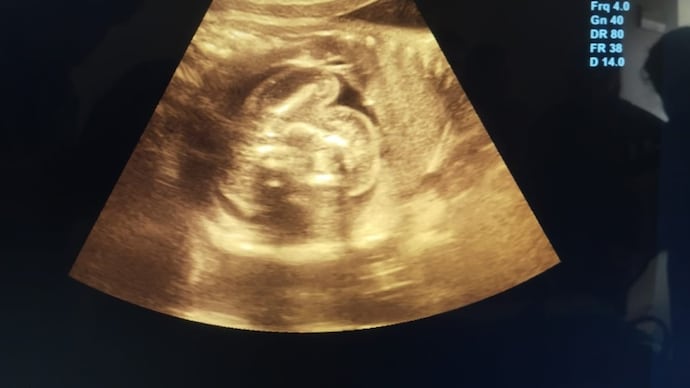A Rare Birth Case That Astonished Medical Professionals
In a world where modern medicine has made childbirth safer and more predictable, some cases still manage to surprise even the most seasoned doctors. This was precisely the situation when 29-year-old Emma Sullivan, a healthy mother-to-be from Portland, Oregon, walked into her local hospital expecting a routine delivery. What happened next not only changed her life but caught the attention of medical experts across the country.
The Unexpected Labor
Emma’s pregnancy had progressed without complications. Regular checkups, ultrasounds, and prenatal care showed no signs of irregularities. So when her labor began two weeks before her expected due date, she and her husband, Mark, weren’t particularly concerned.

Upon arriving at the hospital, Emma was admitted for monitoring. While reviewing her latest ultrasound, doctors noticed something unusual: a second, smaller amniotic sac adjacent to the main one. Confused and intrigued, the medical team prepared for what they assumed was an unusual presentation of twins.
A Stunning Delivery Room Discovery
As the delivery began, doctors carefully navigated the birth of Emma’s healthy baby girl. However, what followed next left the entire team stunned. Inside the secondary sac was what appeared to be an underdeveloped fetus that had stopped growing early in gestation.
This rare occurrence, known in medical terms as "fetus in fetu," happens when a twin embryo is enveloped by its sibling during the early stages of pregnancy. The enveloped fetus does not develop fully and typically remains undetected unless it causes complications or is discovered incidentally.
What Is Fetus in Fetu?

Fetus in fetu is an extremely rare condition, estimated to occur in less than 1 in 500,000 live births. Unlike conjoined twins, where both fetuses grow simultaneously and are partially fused, fetus in fetu involves one fetus becoming encapsulated within the body or womb of the other. In most cases, the underdeveloped fetus is discovered during infancy or early childhood, usually as a mass in the abdomen.
However, in Emma’s case, the discovery happened at birth, making it even more uncommon. The encapsulated fetus had its own amniotic sac and had stopped developing several months into the pregnancy. It posed no risk to Emma or her baby and was removed safely during the delivery procedure.
Reactions from the Medical Community

Dr. Lena Howard, the lead physician during the delivery, described the experience as one of the most unique in her career.
"Deliveries like this remind us how much we still have to learn about the human body. The fact that both Emma and her baby remained healthy throughout the pregnancy is nothing short of remarkable," she said.
Medical researchers at the University of Washington Medical Center have since requested permission to study the case further. The goal is to improve diagnostic tools and potentially identify such conditions earlier in future pregnancies.
Emma's Perspective

In interviews following the birth, Emma expressed gratitude for the professionalism and care she received.
"When I first heard what happened, I was shocked. But knowing that my baby is healthy and safe made everything else feel secondary," she shared. "It’s wild to think that I was carrying something so rare without even knowing."
Emma and her husband have since returned home with their daughter, whom they named Grace. The family is doing well, and Grace is developing like any other newborn.
Why It Matters
Cases like Emma’s highlight the complexity of fetal development and the extraordinary things that can occur during pregnancy. While extremely rare, conditions like fetus in fetu challenge existing medical knowledge and encourage ongoing research into prenatal diagnostics.
These stories also offer reassurance to expectant parents: even in the face of the unexpected, modern medicine is well-equipped to adapt, protect, and respond.
Lessons for Expecting Parents and Healthcare Providers
While no standard prenatal test could have easily detected Emma’s rare case, advancements in imaging technology continue to improve diagnostic accuracy. For parents-to-be, the key takeaways include:
- Maintain regular prenatal appointments
- Ask questions about anything unusual in imaging results
- Trust in experienced medical teams
- Understand that rare does not necessarily mean dangerous
Healthcare professionals, meanwhile, are reminded that every delivery is unique. The importance of flexible thinking, rapid adaptation, and collaborative care in labor and delivery settings cannot be overstated.
The Role of Technology in Modern Pregnancy Care
Ultrasound technology has come a long way over the past two decades. Today’s machines offer high-resolution, real-time imaging that allows obstetricians to monitor fetal development with incredible detail. Even so, some anomalies may go unnoticed, especially if they do not present as a health risk.
The case of Emma Sullivan demonstrates how even advanced tools can miss something incredibly rare. It also underscores the need for continued innovation in prenatal care technologies.
Could It Happen Again?
While the odds are astronomically low, similar cases have been reported in other parts of the world. In 2008, a similar instance occurred in India, where a newborn was found to have a parasitic twin inside the abdomen. In 2015, a related case was reported in Colombia. However, cases discovered at the moment of delivery, as in Emma’s situation, are even rarer.
Experts emphasize that these are isolated medical anomalies and not something expecting parents should be overly worried about. Nevertheless, these cases serve as important reference points in the medical literature.
Moving Forward with Research and Education
The medical community continues to gather data on rare birth conditions like fetus in fetu. With each new documented case, doctors refine their understanding of embryonic development, identify new areas for research, and share knowledge that may assist in future diagnostics or treatment options.
For teaching hospitals and academic medical centers, Emma's delivery is likely to become a part of case studies and educational curricula. It reminds young doctors and medical students that the human body can always surprise us.
A Story That Inspires Curiosity and Confidence
Emma Sullivan’s story isn’t just about a rare condition; it’s a reminder of the strength of modern healthcare and the resilience of mothers. In a situation where the unexpected occurred, the outcome was positive, and the experience may help others in the future.
As Emma put it, "We went in expecting one miracle and came out with two."
Sources:
- National Institutes of Health (NIH): Clinical reports on fetus in fetu
- American Pregnancy Association: Guide to fetal development
- Interview with Dr. Lena Howard, lead physician at Portland General Hospital
- Case studies published in the Journal of Pediatric Surgery
- Emma Sullivan’s personal statements (with permission)

-1753325215-q80.webp)

